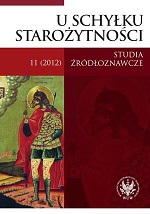PSIOGŁOWI (I) ŚWIĘCI. TOPOS I PRZYCZYNY JEGO WYSTĘPOWANIA
DOG-HEADED (AND) SAINTS. THE THEME AND REASONS OF ITS OCCURRENCE IN EARLY CHRISTIAN LITERATURE
Author(s): Paweł NowakowskiSubject(s): History
Published by: Wydawnictwo Naukowe Sub Lupa
Keywords: święty; psiogłowy; kynokefal; dog-headed; saint
Summary/Abstract: Meetings of saints with dog-headed people is an interesting theme present in the early Christian literature. The Eastern writings concerning St Andrew, St Barnabas and St Christopher show that the assistance of a dog-headed was necessary for Christianization of pagans. The way of portraying a dog-headed and the motif of the change of his wild nature into a human one (leading to acquiring of human virtues) seem to be common for all these text and appear in some further ones also (ex. Life of St. Mercurius in Copto-Arabic Synnaxarium). Another interesting issue is a Gnostic ruler of an astral sphere – archon Erathaoth, portrayed as dog-headed by Origen in Contra Celsum. This figure could have been influenced by an astrological tradition. There may have been various reasons for using this theme in the ancient texts. First, Christian authors were discussing the possibility of conversion of pagans, who were very different from tribes known to Romans for a long period of time. The arguments for this interpretation can be found in Augustine’s De Civitate Dei and Ratramnus’s Epistula de cynocephalis, which both contain a discussion on the alleged human origin of dog-headed creatures and hence conclude that they could be baptised. The other option is the influence of the Egyptian culture and religion. The authors wanted to compromise it by describing a dog-headed creature (similar to Anubis) as a faithful follower of Christ. The same measures were used by Hieronymus in Vita Pauli with respect to centaurs and satyrs.
Journal: U schyłku starożytności - Studia źródłoznawcze
- Issue Year: 2012
- Issue No: XI
- Page Range: 83-106
- Page Count: 24
- Language: Polish

